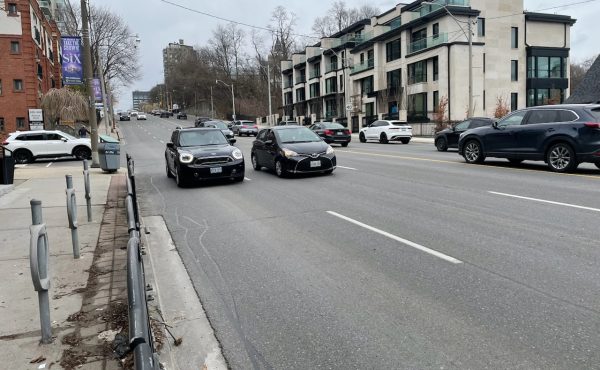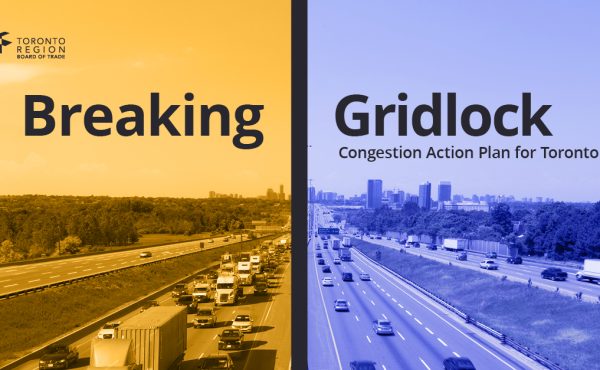
Last Thursday, a car performed an astonishingly dangerous turn in front of traffic at Lake Shore Blvd. and Bay. It collided with another car, and they both spun out of control through the intersection and onto the sidewalk, injuring 6 pedestrians, one of whom later died.
The Toronto Star story about this collision chose to focus on statements by police spokespersons complaining about the way pedestrians use pedestrian countdown signals, despite there being no evidence that this was an issue in the collision. There have already been good commentaries about the apparent blaming of the victims in this story, and a petition has been started asking the police to reconsider the way they respond to these kinds of collisions.
I’d like to focus, here, on the way the police called into question the pedestrian countdown signals. The story says “How pedestrians interpret the newer countdown-type pedestrian signals is becoming a major concern for police.” Const. Hugh Smith describes himself as “Not a strong proponent of the countdown timer on the crosswalk” and says that “What we’re finding down there is people aren’t paying attention to the countdown timers,” adding “I grew up with the stop hand and the walking person.”
Pedestrian countdown signals are in fact a successful and proven way to reduce the number of pedestrians hit in intersections. They were introduced in Toronto because they had successfully reduced vehicle-pedestrian collisions in other jurisdictions. A recent study confirmed that they reduce these collision by about 5 a month in Toronto (a study the Star reported on, although it focused on the fact that they prompt some drivers to try to beat the lights).
What’s more, they work by doing exactly what the police spokespeople say they would like pedestrians to do — pedestrians are more likely to clear the intersection before the light changes, and not start crossing if they don’t have time. When pedestrians only saw the flashing hand, most still started crossing, but many ended up getting caught in the intersection as the light changed because they had no way of knowing how much time they had to cross. The countdown timers have reduced how often that happens.
As I wrote in the latest print issue of Spacing, the average number of vehicle-pedestrian collisions and pedestrian deaths have dropped somewhat since 2004, when the pedestrian countdown signals and other safety measures (such as zebra stripes at crosswalks) began to be rolled out. While there’s no way to prove the cause, it’s reasonable to suppose that the safety measures contributed to this drop.
It seems inappropriate for police to cast doubt on a pedestrian safety measure that has proved successful. While it’s good that police are looking for opportunities to educate the public on safe behaviour, the most effective time to do that would be cases that illustrate that particular behaviour. Every year, some pedestrians who are injured or killed were indeed behaving foolishly — those would be the appropriate times to talk about pedestrian behaviour. When a driver has behaved dangerously and caused injuries and death, that’s a good opportunity to focus on safe driving.
Image from the City of Toronto “We’re all pedestrians” safety campaign, 2005.





8 comments
That comment about the pedestrian countdown signals struck me as odd too. The signals at pedestrian scrambles have the white person lit up for only a few seconds, and then countdowns from 20, and clearly people are expected to cross while they are counting down (otherwise the intersection would sit empty for the majority of the signal, obviously not the intent). Are the cops saying that the rules for countdowns at pedestrian scrambles are different for the rules at regular intersections?
Not only do I find the countdown signals make me a safer pedestrian (I may start crossing in the countdown, but only after making a quick assessment of whether I can make it, and how fast I need to hustle to get across) but I also feel like they make me a safer driver. Some people may be using them to push yellow lights and get through intersections they shouldn’t have made it through, but I use them to warn me when the yellow light is coming, so I can make the decision of whether I’m going to make it through further in advance and prepare to stop if necessary.
When I was living in Brasilia 15 years ago, they were installing some traffic lights where the green counted down not with numbers but there were 4 or 5 green lights on each signal, and they gradually extinguished as you got near the end of the green light, so you got warning that the yellow was coming in advance of the yellow actually coming. I don’t know if they proved to be better or worse in terms of driver behaviour, but I thought it was a pretty interesting idea. I suppose the fact that I’ve never seen them elsewhere suggests they were not, in fact, revolutionary in improving driver behaviour.
Quoting Const. Tony Vella’s comments to the Star: “It’s important for pedestrians to take their time,” he said. “Sometimes they’re in a rush and they’re not paying attention.”
Wait… What??? The same blanket statement could be applied to motorists.
I know that some countries in Europe have the yellow light after the red, indicating a cautious go (as opposed to a yellow after the green). Makes more sense to me. Red should just mean stop. Yellow = check to make sure there aren’t any maniacs blasting through the red, then go.
Dylan, you are spot on. I felt the same when reading that article. Complaining about pedestrians in a rush in the event when many were injured by dangerous driving of a motorist? This cop should give his head a serious shake. In a city like Toronto, we need more cops on foot and on bike, not just the ones who drive in from home in the burb, drive around to do their work and drive home at the end of the day.
I love the pedestrian countdowns both as pedestrian and as a driver. I just don’t understand why in some instances the “walking person” comes first followed by the countdown which makes sense, whereas at many other intersections the countdown comes first and then the walking signal. Should they not be all be set in the same way?
The comment just above mine refers to the inexplicable way that some signals now countdown, but then revert back to the white walking dude if no pedestrians have pressed the button. I have written to the city about this. It doesn’t make any sense and I can’t figure out how this is useful for anyone. Drivers rush to get through as it counts down, but then their green light continues. Pedestrians see the countdown and wait without pressing the button, but then they don’t get the light to cross, and then have to press the button and wait through a whole cycle again. Can anyone enlighten me?
I talked about this phenomenon in an earlier issue of Spacing. These are “semi-actuated” signals (http://www.toronto.ca/transportation/traffic/faq.htm) that rely on a car in the road or a pedestrian to press a button in the minor street in order to tell them to change. But they go through their full cycle (including countdown) so that they will change even if a pedestrian going the other way hits the button during the countdown phase. If no-one does, though, they switch back to the beginning of the cycle.